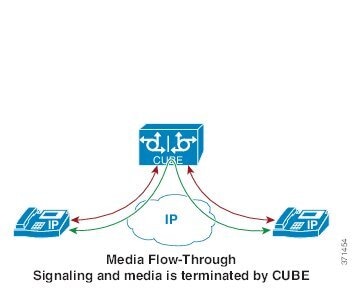Configuring Media
Path
The Media Path feature allows you to configure the path taken by media after a call is established. You can configure Media Path in the following modes:
For information on Delayed Offer to Early Offer, refer to Delayed-Offer to Early-Offer
- Finding Feature Information
- Restrictions for Configuring Media Path
- Information About Media Path
- Feature Information for Media Path
Finding Feature Information
Your software release may not support all the features documented in this module. For the latest caveats and feature information, see Bug Search Tool and the release notes for your platform and software release. To find information about the features documented in this module, and to see a list of the releases in which each feature is supported, see the feature information table at the end of this module.
Use Cisco Feature Navigator to find information about platform support and Cisco software image support. To access Cisco Feature Navigator, go to www.cisco.com/go/cfn. An account on Cisco.com is not required.
Restrictions for Configuring Media Path
For Media Anti-Tromboning
- When Media Anti-Tromboning media path mode is activated, Cisco UBE does not perform supplementary services such as handling REFER-based call transfers or media services such as Secure Real-Time Transport Protocol (SRTP) and SNR.
- Anti-Tromboning does not work if one call leg is media flow-through and the other call leg is Media Flow-Around. Similarly, Anti-Tromboning does not work if one call leg is Session Description Protocol (SDP) pass-through and another call leg is SDP normal.
- H.323 is not supported.
Information About Media Path
Media Flow-Through
Media Flow-Through is a media path mode where media and signaling packets terminate and originate on CUBE. As CUBE is an active participant of the call, this mode is recommended when connected outside an enterprise (untrusted endpoints).

The media flow-through command is used to configure this feature in global VoIP configuration mode (config-voi-serv), dial-peer configuration mode (config-dial-peer) and voice-class configuration mode (config-class). Refer to Modes for Configuring Dial Peers to enter these modes and configure this feature.
Media Flow-Around
Media Flow-Around is a media path mode where signaling packets terminate and originate on CUBE. As media bypasses CUBE and flows directly between endpoints, this mode is recommended when connected within an enterprise (trusted endpoints). Media Flow-Around is supported for both audio and video calls.

The media flow-around command is used to configure this feature in global VoIP configuration mode (config-voi-serv), dial peer mode (config-dial-peer) and voice class configuration mode (config-class). Refer to Modes for Configuring Dial Peers to enter these modes and configure this feature.
Media Anti-Trombone
Media Anti-Tromboning is a media path mode that allows CUBE to detect and avoid loops created by call transfers or call forwards. Loops are restricted to the SIP signaling path and removed from the RTP media path.
The user agent may initiate call forwards and call transfers that are sent towards CUBE as a new SIP INVITE dialog. CUBE considers the original call and the forwarded call as separate unrelated calls. Media anti-tromboning allows CUBE to detect the relation between the calls and resolve the media loop by sending SDP packets back to the sender.
The figure below illustrates how CUBE needlessly loops RTP packets towards the User Agent because it fails to detect the loop.

The figure below illustrates how CUBE detects and avoids the loop with the anti-tromboning feature.

The media anti-trombone command is used to configure this feature in global VoIP configuration mode (config-voi-serv), dial-peer configuration mode (config-dial-peer) and voice-class configuration mode (config-class). Refer to Modes for Configuring Dial Peers to enter these modes and configure this feature.
Feature Information for Media Path
The following table provides release information about the feature or features described in this module. This table lists only the software release that introduced support for a given feature in a given software release train. Unless noted otherwise, subsequent releases of that software release train also support that feature.
Use Cisco Feature Navigator to find information about platform support and Cisco software image support. To access Cisco Feature Navigator, go to www.cisco.com/go/cfn. An account on Cisco.com is not required.
|
Feature Name |
Releases |
Feature Information |
|---|---|---|
|
Configuring Media Path |
12.4(3), 12.4(24)T, 15.0(1)M |
The Media Path feature allows you to configure the path taken by media after a call is established. The following commands were introduced by this feature: media-flow around, media flow-through, media anti-trombone. |
 Feedback
Feedback